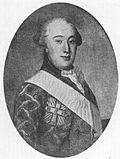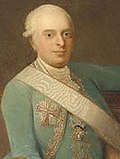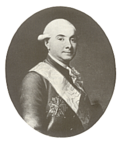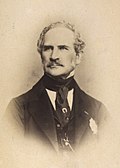| Portrait | Name
(born-died) | Term of office | Monarch(s) | Ref. |
|---|
| Took office | Left office | Time in office |
|---|
 | Johan Christopher von Körbitz
(1612–1682) | 1658 | 1661 | 2–3 years | Frederick III | |
 | Christoffer Sehested [ da ]
(1628–1699) | 1661 | 1670 | 8–9 years | Frederick III | |
 | Helmuth Otto von Winterfeld [ da ]
(1617–1694)
Lord Marshal of the Court of Denmark | 1670 | 1679 | 8–9 years | Christian V | |
 | Frantz Eberhard von Speckhahn [ da ]
(1628–1697)
Lord Marshal of the Court of Denmark (1681–1683) | 1679 | 1681 | 1–2 years | Christian V | |
 | Johan Otto Raben
(1646–1719) | 1683 | 1697 | 13–14 years | Christian V | |
 | Peter Christoph von der Osten [ da ]
(1659–1730) | 1697 | 1699 | 1–2 years | Christian V | |
 | Ludwig Staats von Hahn
(?–?) | 1699 | 1705 | 5–6 years | Frederick IV | |
 | Wilhelm Friedrich von Platen [ da ]
(1667–1732) | 1706 | 1716 | 9–10 years | Frederick IV | |
 | Otto Carl von Callenberg [ de ]
(1686–1759)
Lord Marshal of the Court of Denmark (1717–1719) | 1716 | 1717 | 0–1 years | Frederick IV | |
 | Wilhelm Moritz Münck von Buseck
(?–?) | 1719 | 1721 | 1–2 years | Frederick IV | |
 | Christian von Holstein [ da ]
(1678–1747)
Lord Marshal of the Court of Denmark | 1721 | 1724 | 2–3 years | Frederick IV | |
 | Otto Blome [ da ]
(1684–1738)
Lord Marshal of the Court of Denmark | 1724 | 1730 | 5–6 years | Frederick IV
Christian VI | |
 | Adam Levin von Witzleben [ da ]
(1688–1745)
Lord Marshal of the Court of Denmark | 1730 | 1735 | 4–5 years | Christian VI | |
 | Friedrich Carl von Gram
(1702–1782)
Lord Marshal of the Court of Denmark (1739–1741) | 1735 | 1739 | 3–4 years | Christian VI | |
 | Johann Christoph von Reitzenstein [ da ]
(1698–1767)
Lord Marshal of the Court of Denmark (1743–1746) | 1741 | 1743 | 1–2 years | Frederick V | |
 | Adam Gottlob Moltke
(1710–1792) | 1746 | 1766 | 19–20 years | Frederick V | |
 | Christian Frederik Moltke [ da ]
(1736–1771)
Son of previous. Lord Marshal of the Court of Denmark (1767–1771) | 1766 | 1767 | 0–1 years | Christian VII | |
 | Conrad Holck
(1745–1800) | 1767 | 1770 | 2–3 years | Christian VII | |
 | Henrik Bielke [ da ]
(1750–1811) | 1771 | 1772 | 0–1 years | Christian VII | |
 | Count Christian Frederik Holstein
(1735–1799)
Lord Marshal of the Court of Denmark | 1772 | 1780 | 7–8 years | Christian VII | |
 | Engel Schack [ da ]
(1750–1811)
Lord Marshal of the Court of Denmark | 1780 | 1784 | 3–4 years | Christian VII | |
 | Christian Numsen [ da ]
(1741–1811)
Lord Marshal of the Court of Denmark | 1784 | 1791 | 6–7 years | Christian VII | |
 | Christian Ludvig Kalkreuth
(?–?)
Lord Marshal of the Court of Denmark | 1791 | 1792 | 0–1 years | Christian VII | |
 | Wilhelm Theodor Wegener [ da ]
(1724–1792) | 1791 | 1792 | 0–1 years | Christian VII | |
 | Count Ferdinand Anton Christian Ahlefeldt
(?–?) | 1792 | 1794 | 1–2 years | Christian VII | |
 | Adam Wilhelm Hauch [ da ]
(1755–1838)
Lord Marshal of the Court of Denmark (1798–1838). Also Lord Chamberlain of Denmark. | 1794 | 1798 | 3–4 years | Christian VII
Frederick VI | |
 | Christian Ove Haxthausen [ da ]
(1777–1842)
Lord Marshal of the Court of Denmark (1840–1842) | 1838 | 1840 | 1–2 years | Frederick VI
Christian VIII | |
 | Joachim Godsche von Levetzau [ da ]
(1782–1859)
Lord Marshal of the Court of Denmark (1845–1859) | 1842 | 1845 | 2–3 years | Christian VIII
Frederick VII | |
 | Carl Ludvig Løvenskjold
(1822–1898)
Lord Marshal of the Court of Denmark (1881–1898) | 1860 | 1881 | 20–21 years | Frederick VII
Christian IX | |
 | Waldemar Tully Oxholm
(1805–1876)
Lord Marshal of the Court of Denmark (1863–1876). Also Lord Chamberlain of Denmark. | 1863 | 1876 | 12–13 years | Christian IX | |
 | Oscar Siegfred O'Neill Oxholm [ da ]
(1863–1948)
Also Lord Chamberlain of Denmark. | 1898 | 1906 | 7–8 years | Christian IX | |
 | Count Joachim Moltke [ da ]
(1857–1943) | 1906 | 1908 | 1–2 years | Frederik VIII | |
 | Count Frands Brockenhuus-Schack [ da ]
(1863–1948)
Lord Marshal of the Court of Denmark (1911–1912). Last Lord Marshal of the Court of Denmark. | 1908 | 1911 | 2–3 years | Frederik VIII
Christian X | |
 | William Carlton Rothe
(?–?) | 1912 | 1926 | 13–14 years | Christian X | |
 | Carl Julius Engelbrecht Juel [ da ]
(1862–1941) | 1926 | 1939 | 12–13 years | Christian X | |
 | Count Christopher Trampe [ da ]
(1879–1957) | 1939 | 1947 | 7–8 years | Christian X | |
 | Johan Vest [ da ]
(1893–1966) | 1947 | 1963 | 15–16 years | Frederik IX | |
 | Holger Eigil Wern
(?–?) | 1963 | 1968 | 4–5 years | Frederik IX | |
 | Count Karl Christian Trampe [ da ]
(1924–2014) | 1968 | 1972 | 3–4 years | Frederik IX | |
 | Kjeld Gustav Knuth-Winterfeldt [ da ]
(1908–1992) | 1972 | 1976 | 3–4 years | Margrethe II | |
 | Hans Sølvhøj [ da ]
(1919–1989) | 1976 | 1989 | 12–13 years | Margrethe II | |
 | Søren Haslund-Christensen [ da ]
(1933–2021) | 1989 | 2003 | 13–14 years | Margrethe II | |
 | Ove Ullerup [ da ]
(born 1951) | 1 September 2003 | 1 September 2014 | 11 years, 0 days | Margrethe II | |
 | Michael Ehrenreich [ da ]
(born 1954) | 15 February 2015 | 31 March 2021 | 6 years, 44 days | Margrethe II | |
 | Kim Kristensen [ da ]
(born 1964) | 31 March 2021 | 14 January 2024 | 2 years, 289 days | Margrethe II | |
 | Christian Schønau [ da ]
(born 1966) | 14 January 2024 | Incumbent | 1 year, 283 days | Frederik X | [5] |













